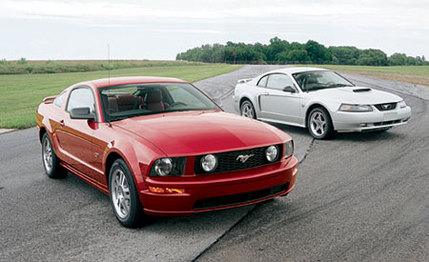
 First Drive Review
First Drive Review
The first Mustang, introduced on April 17, 1964, was a Falcon-based four-seater that was not dubbed a sports coupe or GT but rather a "personal car." Purists of the day hooted at the base model's engine, a feeble 101-hp inline six-cylinder. They also scoffed at its Euro-style pretensions—bucket seats, a long hood, a short rear deck. But for Ford, it was an enormous blast out of the park in the exploding market known as "baby boomers." In one year, Ford sold 418,812 Mustangs. It remains the only car ever to simultaneously grace the covers of both Time and Newsweek.
It's not likely that this new 2005 Mustang will equal the dramatics of that record, but the car is nonetheless attracting huge attention. This is the first mechanically and stylistically all-new Mustang since 1980, and it inherits the mantle of the longest-lived and most successful machine of its class. Despite the Mustang's advanced age in 2003, Ford still sold more than 140,000 of them. Meanwhile, the Chevy Camaro, the Pontiac Firebird, the Mercury Cougar, the Plymouth Barracuda, and the Dodge Challenger are all occupants—at least for the time being—of Detroit's junkyard.
What awaits tens of thousands of enthusiasts is a machine that not only captures the aura of the early Mustangs but also seems capable of kicking its way out of the stable and bucking into an entirely new market segment.
Consider a densely packed four-passenger coupe offering an entry-level 210-hp, 4.0-liter SOHC 60-degree V-6 with a five-speed automatic or manual for less than $20,000. Or a GT version with a 300-hp, 4.6-liter, 24-valve SOHC 90-degree V-8, also with a five-speed automatic or manual, for less than $25,000. If these price points can be achieved, the 2005 Mustang will go unchallenged by any rival, domestic or foreign. (One can imagine designers at GM and DaimlerChrysler furiously scribbling concepts of new Barracudas, Challengers, Camaros, and Firebirds to match it.)
The Mustang is part of a substantial number of new models being introduced by Ford in the coming year, including the Five Hundred and Mercury Montego sedans, a reskinned Focus, the Freestyle and freshened Escape SUVs, as well as the limited-production Ford GT.
The Mustang will be built on a highly modified version of the company's D2C platform that carries the Lincoln LS and Jaguar S-type sedans, a structure offering anvil-like rigidity to the Mustang chassis.
One of the major changes to this platform is in the suspension. Instead of the front control arms and rear multilink setup used in the platform's bucks-up cars, the Mustang gets a simpler strut-front and three-link coil-over solid-axle rear suspension with a Panhard rod. Vented disc brakes are retained at all four wheels. If the layout seems primitive, the overall execution seems first-rate, with optimized geometry, rigid suspension pickup points, and the latest design practice.
The styling of the coupe, with its wide, forward-leaning grille, small quarter-windows, and fastback roofline, is powerfully retro, with images fried into one's brain of the Mustang Steve McQueen drove in Bullitt and the Bud Moore-Parnelli Jones -George Follmer Trans-Am cars. Despite an increase of 5.8 inches in the wheelbase to 107.1 and an overall length of 187.6 inches (4.4 inches longer), the bodywork is so neatly integrated that the package transmits an impression of understated modest size. Although the GT sports a small rear wing, the look is otherwise accomplished without the addition of cornball scoops, ground-effects skirts, spoilers, and decal pasting.
The retro look carries over into the Mustang's interior with a full-width, brushed-aluminum instrument panel; two big round instrument clusters; and a three-spoke steering wheel that recalls the spare, airbag-free wheels from 40 years ago. One modern element is a unique "color configurable instrument cluster." With the touch of a button, 125 different hues for the speedometer and other gauges can be created. This, according to Ford types, speaks to the growing desire of customers to "personalize" their automobiles. How this urge will be met by psychedelic instrument displays has yet to be confirmed.
Our first exposure to the car came during a 140-mile drive to GingerMan Raceway in western Michigan. On a combination of back roads and I-94, the 2005 Mustang GT felt rock-solid and rattle-free. Wind and road noise were both moderate, although the V-8 engine delivers a satisfying rap when you bury the throttle and wind toward the 6000-rpm redline.
The Mustang GT's ride motions felt firm and controlled, just as one expects from a performance machine with 300 horsepower. But there's enough compliance in the suspension that not even sharp-edged bumps can cause harsh crashes or bangs. Steering feel on the highway is excellent, with a combination of great stability and a natural effort increase as you wind into corners.